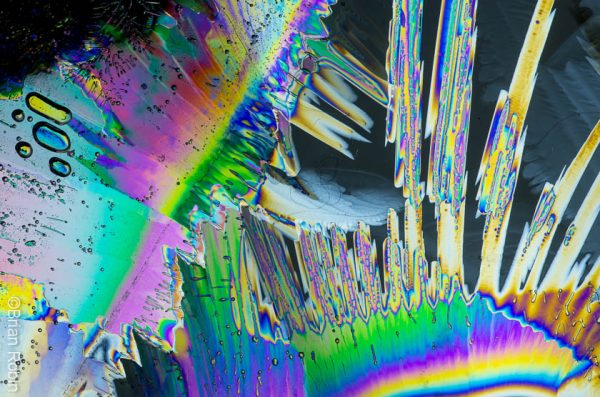
To date, I’ve been content to set water out overnight and examine nature’s icy creations in the morning. A late February warm spell made this proceedure impossible, with unseasonably warm overnight temperatures that turned my liquid water into puddles of slightly colder water. Nice, I guess, but not what I was after for a photographic subject.
Early March featured a nice cold snap and I returned to laying out sheets glass covered in water in the evening. After almost 2 weeks of an early onset spring induced ice-photography hiatus, impatience had set in and I couldn’t wait until morning. Bedtime on hold, I started neurotically checking the state of my ice-to-be every few minutes to see what was happening.
It was delightful.
I have a whole new host of forms and shapes to explore, like the feathery image above, or what I suspect is a deep sea monster below:

While watching these shapes unfold, and realizing I was photographing the same sections of ice over and over as they evolved and took shape, I figured it was time to try a technique that’s new to me. Something to let you, from the warm comfort of your couch, better enjoy water as it takes on its icy crystallized form, and see more than just the limited time and space cross-sections I pick out.
There’s no sound, no fancy camera movements, just a thin layer of water on glass, in the freezing cold, between two polarizers for the awesome birefringence colours, and a bit of fun.
I give you my very first time-lapse:
I especially enjoyed around the 17 second mark with the ice forms a few cracks. Epic ice fissures of a miniature scale!
All four videos on this page have these traits in common:
- Air temperature was roughly -8C when the room-temperature water went out.
- They range from 45 to 145 minutes of freezing time, followed by a few minutes of a hairdryer.
- They represent a real-life area about 13cm across.
- The time compression varies throughout each video, the ice grows relatively fast at the start, slows down as the colours are filling out, followed by a relatively rapid melting. I’ve adjusted the frame rates for a prettier video.
- They are composed of 450 or more single still images.
The ice in the next video forms significantly differently from the first video. Without diving into the science, ice prefers to start forming on pieces of existing ice or mineral dust, or some other nucleation site, as opposed to just crystallizing spontaneously in the middle of totally pure H2O. It’s theoretically possible to slowly cool totally pure and still water down to about -40C before ice starts to form. In practice, impurities in the water, or the container, and agitating the liquid will all contribute to ice crystals appearing at temperatures much closer to our familiar 0C benchmark.
In this case, a fierce wind was stirring up our not-completely-weather-sealed back room flinging fine pellets of snow everywhere. This water was also exposed to the air on top (not pressed between two pieces of glass like I often do) and you can see it swirling around as the crystals start to appear in the centre. We’re looking at a large number of scattered nucleation sites where little crystals form:
My third attempt had calmer winds, allowing the water to cool below freezing with little agitation, and we have larger ‘feathers’ forming throughout, like in the first video:
I swear I’m not trying to hypnotize you with flashing colours.
Up next is more feathers, but I particularly liked the melting portion of this final video. The colours from birefringence are dependent on a few factors, one of them being the thickness of the ice. If you stare at one small section during the melting, you can see how it cycles through the birefringece colour palette as the depth of the ice fades away.
Look into the light.
Or I might be trying to hypnotize you over the internet with flashing colours, but it’s worth the risk. Trust me.
Near the end, the remaining section breaks free and does a little float as it melts away into nothingness.
With my first basic time-lapses under my belt, it feels like the dawn of a new addiction… my notebook is filling up with ideas beyond still photography, and beyond my available free time. Exciting!
Thanks for watching my little experiments!


Hi Brian
Susan and I enjoyed receiving one of your gray tree frog cards from Dyan and Randy. I enjoyed visiting this site. We miss you and Sarah and your whole clan.
Love to you all
John and Susan